There is a growing demand for sustainable, chemical-free solutions worldwide as traditional lake management tools often prove ineffective, entail significant environmental consequences, and focus on short-term "damage control" rather than preventing future water quality issues. Moleaer’s nanobubble technology offers long-term solutions to the most pressing water body challenges.

Globally, harmful algae blooms (HABs) are intensifying, posing significant threats to water bodies worldwide. HABs are defined as algae blooms that produce toxic effects on people, fish, and other organisms. Rising temperatures and altered precipitation patterns exacerbate nutrient runoff from agricultural and urban areas, leading to increased algae proliferation. The decomposition of large quantities of algae depletes oxygen levels in water, causing fish kills and disrupting aquatic ecosystems. Additionally, toxins released by harmful algae can cause illness or be fatal to humans and wildlife. These impacts have profound economic consequences on adjacent communities by rendering water unfit for recreational activities and jeopardizing industries reliant on clean water sources, such as fisheries and tourism.
To address this, nanobubble treatment by Moleaer offers a sustainable, long-term solution by oxygenating the entire water column, particularly the lake bottom where sediments, a major source of internal nutrient loading in most lakes, are found. By reversing oxygen-depleted conditions at the bottom of the lake, nanobubbles help immobilize phosphorus and curtail nitrogen release, reducing algae growth and preventing future blooms. Increasing the lake's oxidation-reduction potential (ORP) further enhances its resilience to algae toxin loading and reduces muck accumulation, making the lake a safer environment for human recreation and aquatic life.
Download the Case Study to learn how City of South Daytona reduced algae blooms in their stormwater basin.

Urban lakes are particularly susceptible to eutrophication, a process characterized by excessive nutrient enrichment leading to algal blooms, oxygen depletion, and degraded water quality. Urbanization intensifies nutrient inputs into lakes through runoff from fertilized lawns, paved surfaces, and sewage systems, exacerbating eutrophication. The influx of nutrients, primarily nitrogen and phosphorus, fuels the rapid growth of algae and aquatic plants, forming thick mats on the water surface and depleting oxygen levels as they decompose. These anaerobic conditions make it very difficult for organisms to survive, resulting in fish kills, and significantly slow down decomposition, causing organic matter to accumulate at the bottom of lakes. As a result, urban lakes suffer from decreased biodiversity, foul odors, and increased susceptibility to recurring toxic algal blooms, posing significant ecological and public health concerns.
Addressing eutrophication in urban lakes requires holistic management approaches that mitigate nutrient inputs, enhance water quality, and restore ecological balance. Moleaer is helping address this with nanobubble technology by oxygenating the entire water column, especially the lake bottom where sediments are a major source of internal nutrient loading. Reversing anaerobic conditions at the bottom helps immobilize phosphorus and restarts aerobic microbial activity, reducing nitrogen release and internal nutrient loading. Additionally, increasing the oxidation-reduction potential (ORP) of the water enhances its ability to break down contaminants and organic matter, improving overall water quality and ecosystem resilience.
Learn More About Eutrophication by reading our blog about urban lakes like Lake Elsinore, California.

Muck, a thick layer of decomposing organic matter at the bottom of lakes, poses significant problems for lake ecosystem health by reducing water clarity, depleting oxygen levels, and impairing the quality of habitat available for aquatic organisms.
Traditional control methods like muck dredging are costly and ecologically harmful. Dredging requires significant financial investment for permits, equipment, labor, and waterbody closures, and disposing of dredged materials adds to the overall costs. Ecologically, dredging disrupts sediment layers, releases nutrients and toxins, harms aquatic vegetation and wildlife, and often worsens water quality, highlighting the need for sustainable lake management approaches.
Moleaer helps solve this problem by oxygenating the entire water column, particularly the lake bottom where muck often accumulates. By reversing anaerobic conditions, Moleaer’s nanobubble technology restarts aerobic microbial activity, which digests the accumulated muck, increases water depth, and enhances fish habitat and aquatic vegetation growth. Additionally, increasing the oxidation-reduction potential (ORP) of the water improves its ability to break down organic matter, making the lake more resilient to future muck accumulation.

Discover how a private rock quarry lake owner reduced muck and algae blooms without mechanical dredging.

Foul odors in water bodies are often caused by hydrogen sulfide (H2S), which forms under oxygen-depleted (anaerobic) conditions. These odors result from microbial processes that produce H2S and methane in the absence of oxygen.
Moleaer helps combat this problem by oxygenating the entire water column, particularly the lake bottom where sediments are. Reversing anaerobic conditions and making them aerobic significantly reduces the production of these gases and foul odors.
Additionally, Moleaer's nanobubble technology helps reduce concentrations of taste and odor (T&O) compounds, such as Geosmin and 2-methylisoborneol (MIB), which are produced by cyanobacteria and cause musty and earthy off-flavors in surface waters. Nanobubble treatment reduces nutrient levels that fuel cyanobacteria growth and increases the volatilization and oxidation rates of Geosmin and MIB, improving the overall quality and odor of the water.
Read the Press Release About Dominguez Channel and how nanobubbles helped eliminate H2S formation to naturally restore the water quality.

Globally, harmful algae blooms (HABs) are intensifying, posing significant threats to water bodies worldwide. HABs are defined as algae blooms that produce toxic effects on people, fish, and other organisms. Rising temperatures and altered precipitation patterns exacerbate nutrient runoff from agricultural and urban areas, leading to increased algae proliferation. The decomposition of large quantities of algae depletes oxygen levels in water, causing fish kills and disrupting aquatic ecosystems. Additionally, toxins released by harmful algae can cause illness or be fatal to humans and wildlife. These impacts have profound economic consequences on adjacent communities by rendering water unfit for recreational activities and jeopardizing industries reliant on clean water sources, such as fisheries and tourism.
To address this, nanobubble treatment by Moleaer offers a sustainable, long-term solution by oxygenating the entire water column, particularly the lake bottom where sediments, a major source of internal nutrient loading in most lakes, are found. By reversing oxygen-depleted conditions at the bottom of the lake, nanobubbles help immobilize phosphorus and curtail nitrogen release, reducing algae growth and preventing future blooms. Increasing the lake's oxidation-reduction potential (ORP) further enhances its resilience to algae toxin loading and reduces muck accumulation, making the lake a safer environment for human recreation and aquatic life.
Download the Case Study to learn how City of South Daytona reduced algae blooms in their stormwater basin.

Urban lakes are particularly susceptible to eutrophication, a process characterized by excessive nutrient enrichment leading to algal blooms, oxygen depletion, and degraded water quality. Urbanization intensifies nutrient inputs into lakes through runoff from fertilized lawns, paved surfaces, and sewage systems, exacerbating eutrophication. The influx of nutrients, primarily nitrogen and phosphorus, fuels the rapid growth of algae and aquatic plants, forming thick mats on the water surface and depleting oxygen levels as they decompose. These anaerobic conditions make it very difficult for organisms to survive, resulting in fish kills, and significantly slow down decomposition, causing organic matter to accumulate at the bottom of lakes. As a result, urban lakes suffer from decreased biodiversity, foul odors, and increased susceptibility to recurring toxic algal blooms, posing significant ecological and public health concerns.
Addressing eutrophication in urban lakes requires holistic management approaches that mitigate nutrient inputs, enhance water quality, and restore ecological balance. Moleaer is helping address this with nanobubble technology by oxygenating the entire water column, especially the lake bottom where sediments are a major source of internal nutrient loading. Reversing anaerobic conditions at the bottom helps immobilize phosphorus and restarts aerobic microbial activity, reducing nitrogen release and internal nutrient loading. Additionally, increasing the oxidation-reduction potential (ORP) of the water enhances its ability to break down contaminants and organic matter, improving overall water quality and ecosystem resilience.
Learn More About Eutrophication by reading our blog about urban lakes like Lake Elsinore, California.

Muck, a thick layer of decomposing organic matter at the bottom of lakes, poses significant problems for lake ecosystem health by reducing water clarity, depleting oxygen levels, and impairing the quality of habitat available for aquatic organisms.
Traditional control methods like muck dredging are costly and ecologically harmful. Dredging requires significant financial investment for permits, equipment, labor, and waterbody closures, and disposing of dredged materials adds to the overall costs. Ecologically, dredging disrupts sediment layers, releases nutrients and toxins, harms aquatic vegetation and wildlife, and often worsens water quality, highlighting the need for sustainable lake management approaches.
Moleaer helps solve this problem by oxygenating the entire water column, particularly the lake bottom where muck often accumulates. By reversing anaerobic conditions, Moleaer’s nanobubble technology restarts aerobic microbial activity, which digests the accumulated muck, increases water depth, and enhances fish habitat and aquatic vegetation growth. Additionally, increasing the oxidation-reduction potential (ORP) of the water improves its ability to break down organic matter, making the lake more resilient to future muck accumulation.

Discover how a private rock quarry lake owner reduced muck and algae blooms without mechanical dredging.

Foul odors in water bodies are often caused by hydrogen sulfide (H2S), which forms under oxygen-depleted (anaerobic) conditions. These odors result from microbial processes that produce H2S and methane in the absence of oxygen.
Moleaer helps combat this problem by oxygenating the entire water column, particularly the lake bottom where sediments are. Reversing anaerobic conditions and making them aerobic significantly reduces the production of these gases and foul odors.
Additionally, Moleaer's nanobubble technology helps reduce concentrations of taste and odor (T&O) compounds, such as Geosmin and 2-methylisoborneol (MIB), which are produced by cyanobacteria and cause musty and earthy off-flavors in surface waters. Nanobubble treatment reduces nutrient levels that fuel cyanobacteria growth and increases the volatilization and oxidation rates of Geosmin and MIB, improving the overall quality and odor of the water.
Read the Press Release About Dominguez Channel and how nanobubbles helped eliminate H2S formation to naturally restore the water quality.
Moleaer's technology provides versatile solutions for a wide range of water bodies, including lakes, ponds, stormwater systems, channels, rivers, and more.
Moleaer plays a crucial role in enhancing community lakes, particularly those managed by Homeowner Associations (HOAs) or Lake Districts. By employing nanobubble technology, Moleaer oxygenates the entire water column, including sediment-laden lake bottoms where nutrients accumulate. This process not only improves water clarity and reduces foul odors but also mitigates algae growth by limiting nutrient availability. HOAs and Lake Districts benefit from reduced reliance on chemical treatments and mechanical dredging, which are costly and ecologically disruptive. Moleaer's sustainable approach helps maintain healthier ecosystems, enhancing recreational enjoyment and preserving property values for the community.
Tri-Lakes Management District in Wisconsin reduces algae, improves water clarity and reduces muck in their marina over a 70-day pilot study.
Moleaer empowers lakeside homeowners and private lake enthusiasts with advanced solutions designed to elevate water quality and revive ecosystems. Whether targeting water around docks or managing expansive lakes and ponds, Moleaer's adaptable nanobubble technology meets the unique challenges of any water body, from shallow areas to deep expanses. Safe for aquatic life, this innovative approach aids in muck digestion and fosters habitat restoration, enhancing the natural environment. By curbing algae blooms, improving oxygenation, and enhancing water clarity, Moleaer not only enriches recreational experiences but also safeguards property values, ensuring lasting enjoyment and sustainability for lakefront communities and private estates alike.
Discover how a lake owner in Wisconsin reduced algae and improved water clarity in his private trout pond.
Moleaer gives municipal workers managing lakes peace of mind by offering continuous, chemical-free water treatment solutions. Using nanobubble technology, Moleaer provides a sustainable approach that eliminates the need for handling or applying chemicals. This method ensures ongoing improvement in water quality, reduces algae bloom severity and occurrence and enhances oxygen levels without disrupting aquatic ecosystems. Municipalities benefit from reduced operational complexity and environmental impact, ensuring safer, healthier lakes for community enjoyment. Moleaer supports municipalities in maintaining pristine water resources and promoting sustainable urban environments through eco-friendly lake management practices.
For instance, the City of South Daytona in Florida’s conventional methods struggled to control algae blooms and maintain water quality in stormwater retention ponds. Moleaer's Kingfisher nanobubble generator increased dissolved oxygen levels throughout the water column and increased the oxidation-reduction potential (ORP), resulting in less algae growth and the elimination of chemical applications.
Moleaer plays a crucial role in addressing eutrophication in urban lakes by utilizing nanobubble technology to enhance water quality. Urban lakes are particularly prone to eutrophication due to nutrient runoff from urban areas, which accelerates algae and aquatic plant growth, depleting oxygen levels and harming aquatic life.
Moleaer's nanobubbles oxygenate the entire water column, including sediment-laden lake bottoms where nutrients accumulate. This process helps mitigate eutrophication by reducing nutrient availability for algae, promoting clearer water and healthier aquatic ecosystems. By improving oxygen levels and enhancing the oxidation-reduction potential (ORP), Moleaer's technology aids in restoring urban lakes, making them more resilient to nutrient loading and improving overall water clarity and biodiversity.
Dissolved Oxygen into the Sediment
Healthier Odor-Free Ecosystem
More Clarity & Healthier Fish Habitats
Muck Reduction & Improved Sediment Hardness
Reduced Internal Nutrients

Nanobubble technology plays a crucial role in transforming anoxic conditions in lakes and ponds into oxic conditions, significantly impacting the cycling of nitrogen and phosphorus. Under anoxic conditions, iron or manganese-bound phosphorus gets reduced, releasing Fe²⁺ (or Mn²⁺) and PO₄³⁻, leading to a net release of phosphorus into the water. Anoxic conditions also result in the accumulation of nitrogen (in the form of ammonium), due to higher ammonification rates, as compared to nitrification and denitrification rates. This leads to a net nitrogen release (in the form of ammonium) into the water column.
However, introducing nanobubbles turns the bottom of lakes oxic, promoting the oxidation of Fe²⁺ (or Mn²⁺) to Fe³⁺ (or Mn³⁺), which binds with HPO₄²⁻, leading to phosphorus sequestration. Additionally, under oxic conditions, nitrification and denitrification rates surpass ammonification rates, resulting in a reduction in net nitrogen release into the water column. This ultimately reduces the availability of nutrients that fuel algae growth, improving the overall quality of surface water in lakes and ponds.

Easy to Install & Maintain
Single Treatment Point for Large Areas
Flexible Air Sources
Works in All Water Bodies

Learn more about our nanobubble generation systems designed to target the root cause of common lake and pond issues like muck, algae, foul odors and excess nutrients.
We designed the Kingfisher with hard-to-treat water bodies in mind. The Kingfisher is right for you if you are managing golf course ponds and waterways, HOA and condo lakes and ponds or even residential lakefronts. The Kingfisher can even be used for small irrigation ponds and canals, producing a myriad of other benefits for growers.
Kingfisher Product Details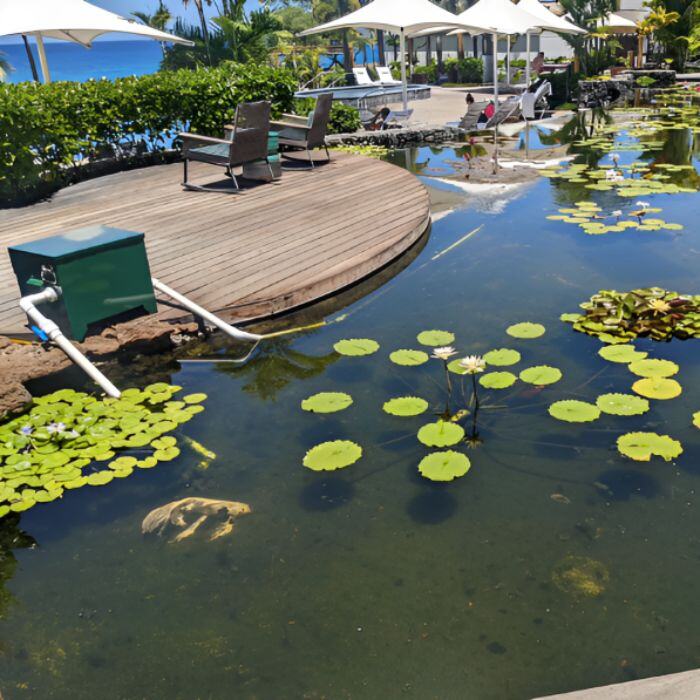
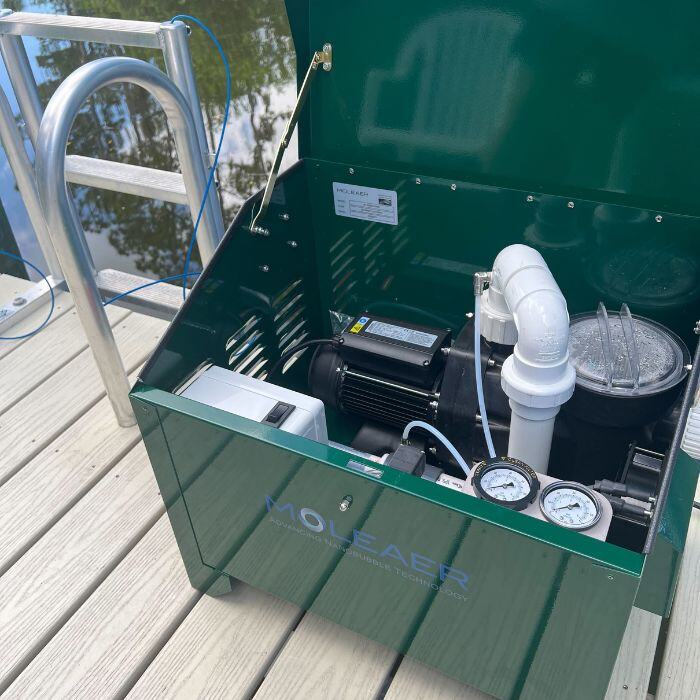
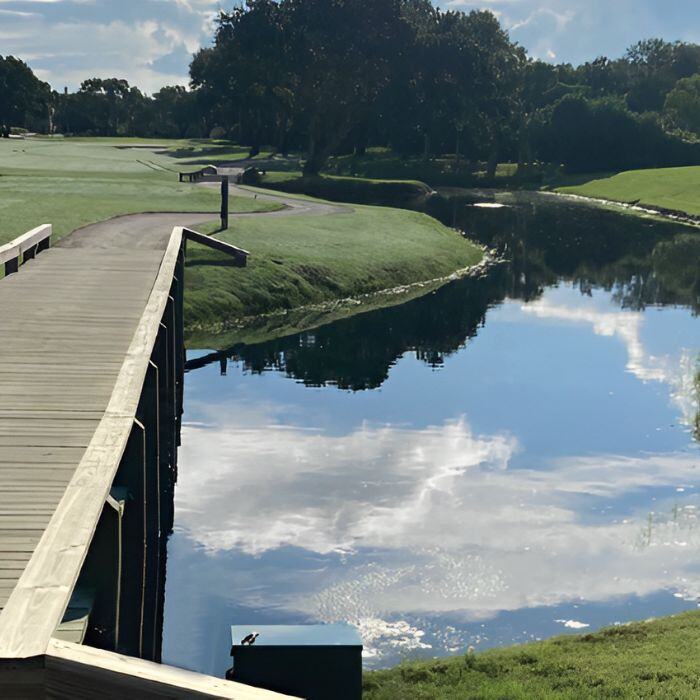
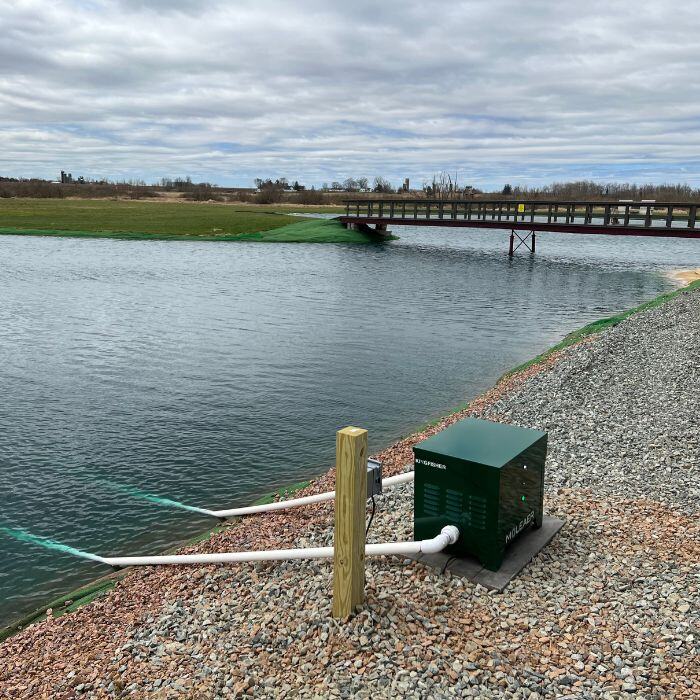
.jpg)
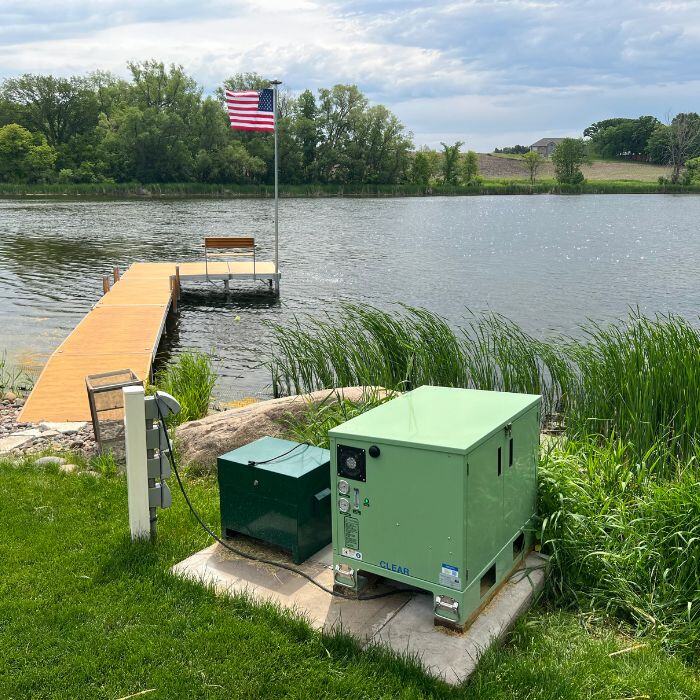
Moleaer's Clear nanobubble generators inject nanobubbles in water to prevent algae blooms and promote healthy conditions from the sediment to the surface.
Clear Product Details
.jpg)
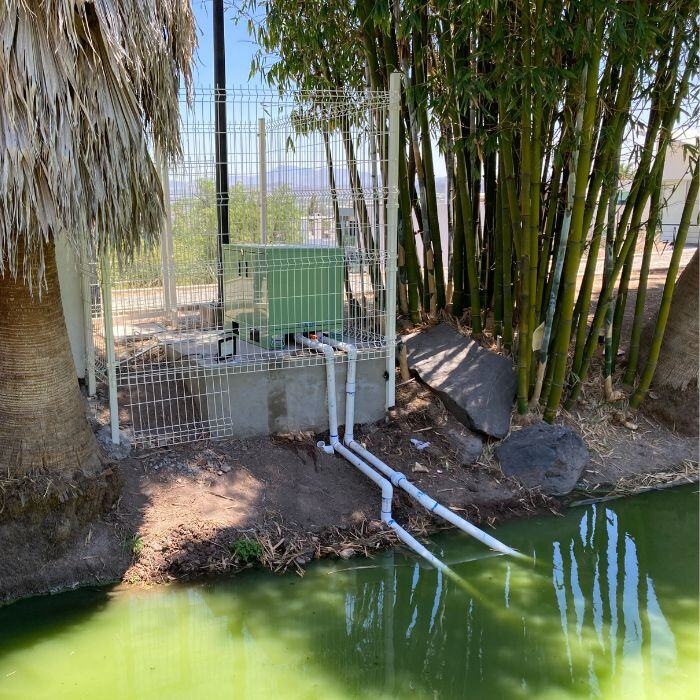
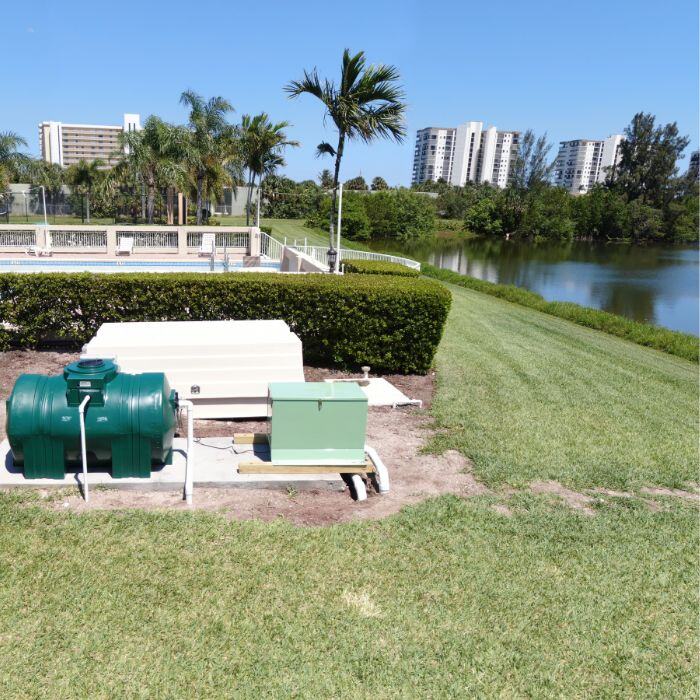
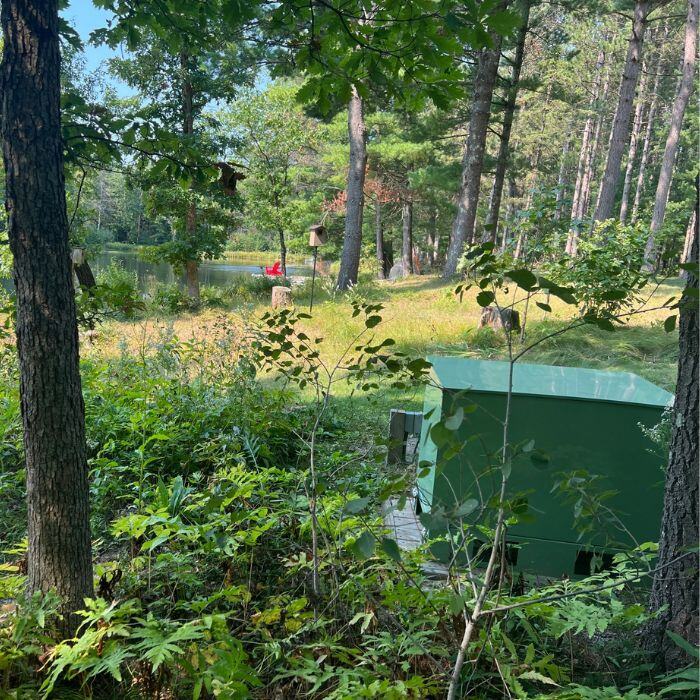
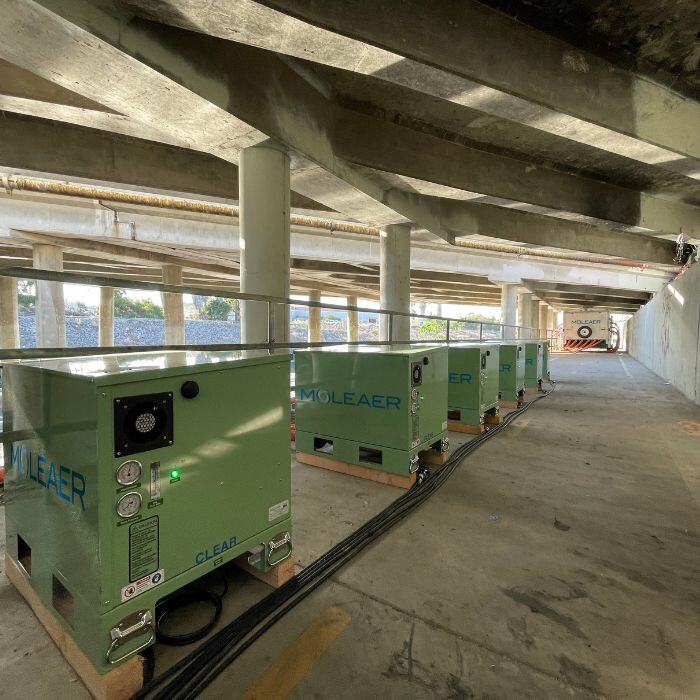
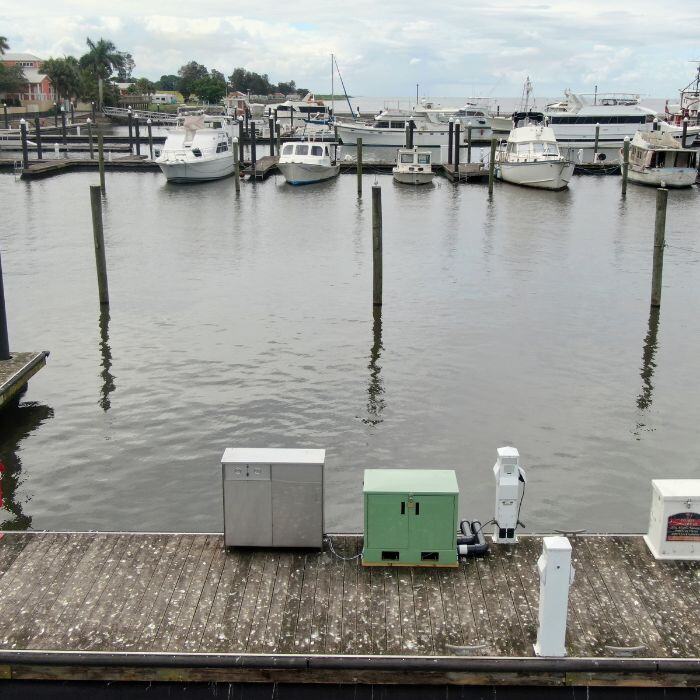
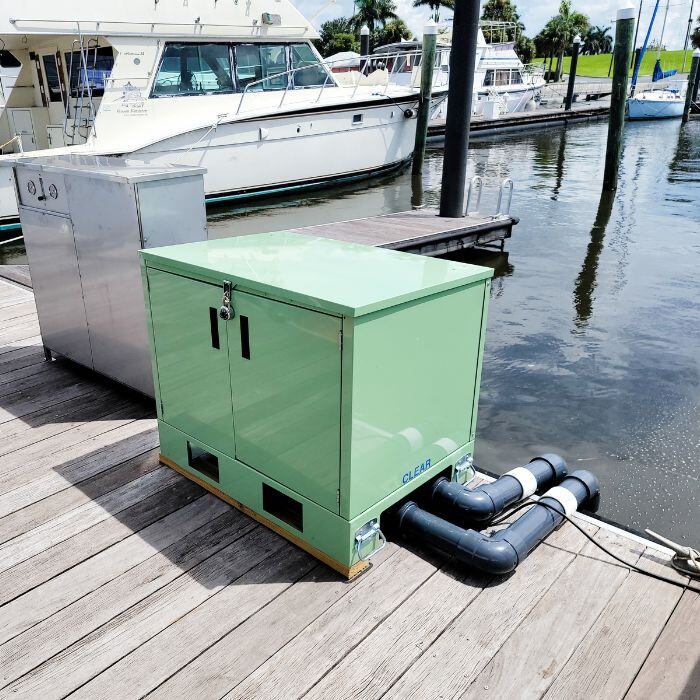
Moleaer’s Neo N generators come in two configurations so you can choose the best fit for your industry, body of water, and quality control needs.
Neo Product Details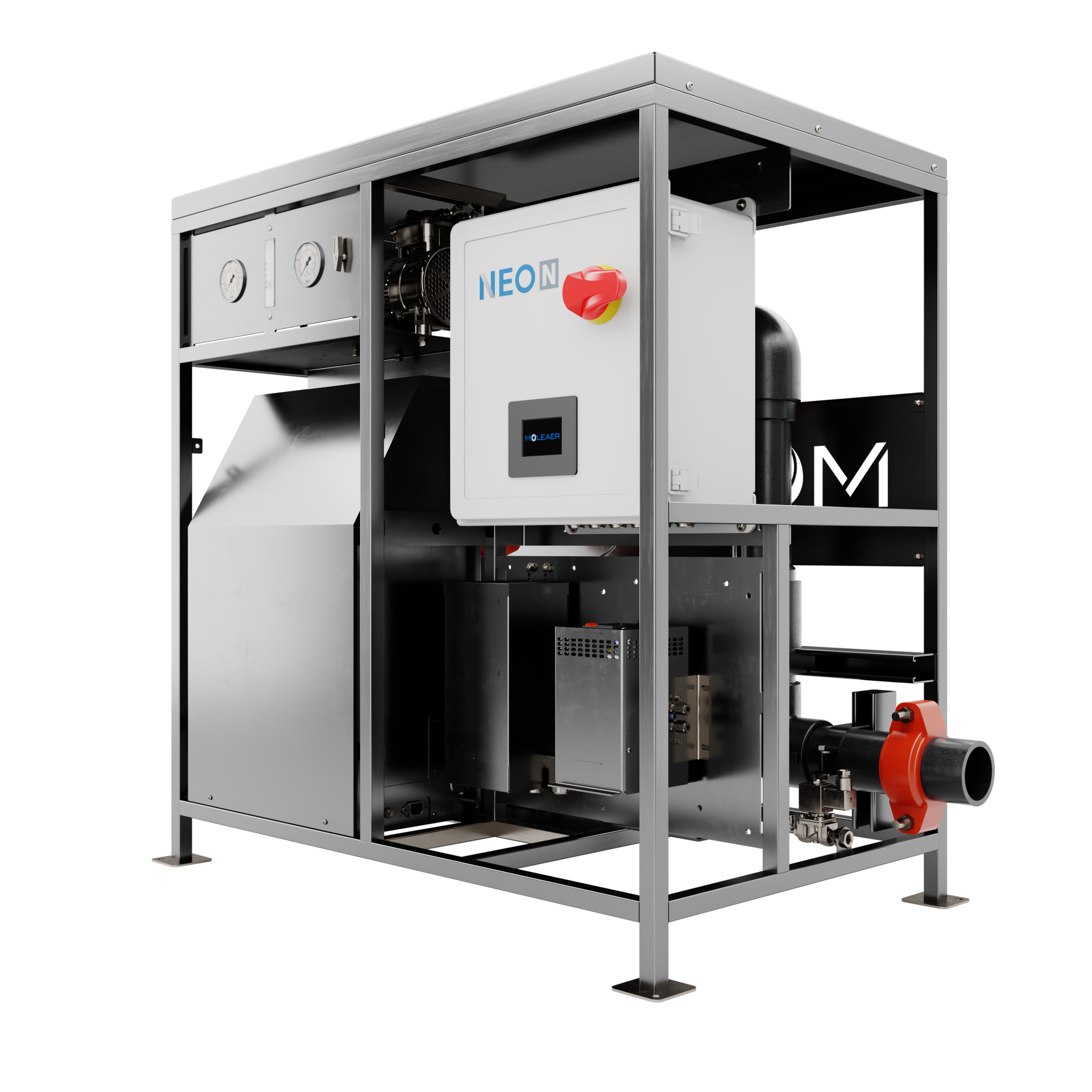
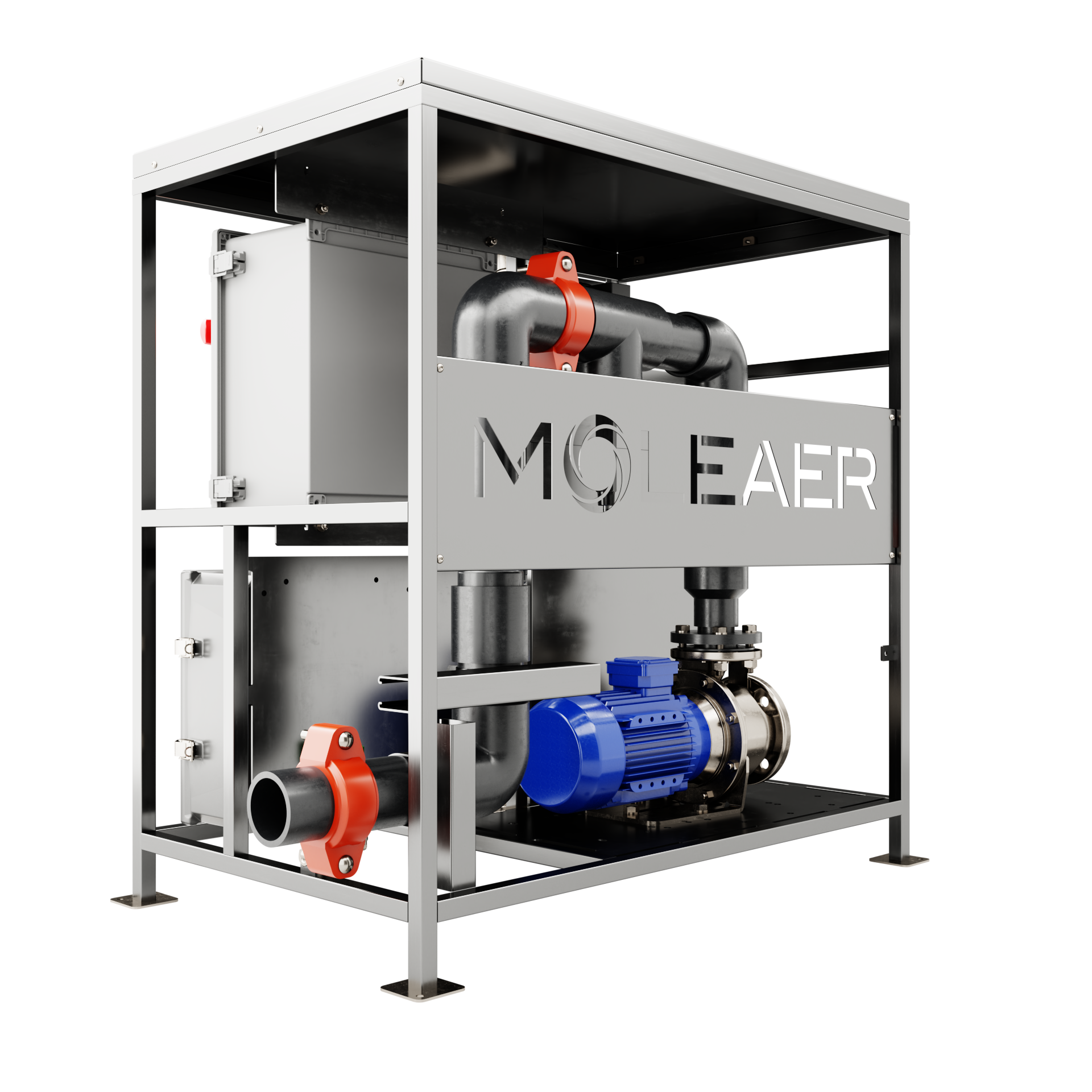
With our Titan product series, Moleaer offers fully customizable nanobubble generation solutions for large-scale industrial and municipal applications to deliver the power of nanobubbles no matter your current system configuration. Our modular nanobubble generators, pumps and gas sources give you the flexibility to choose what works best in your water body.
Titan Series Details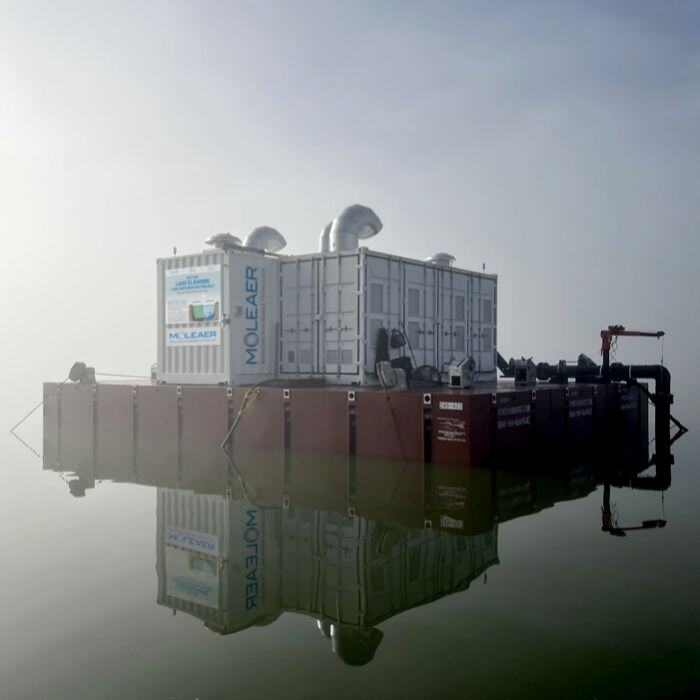
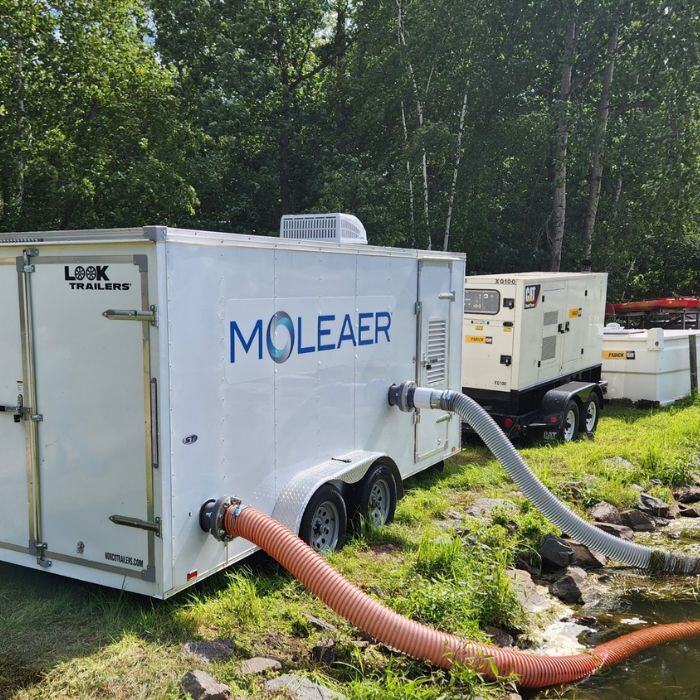
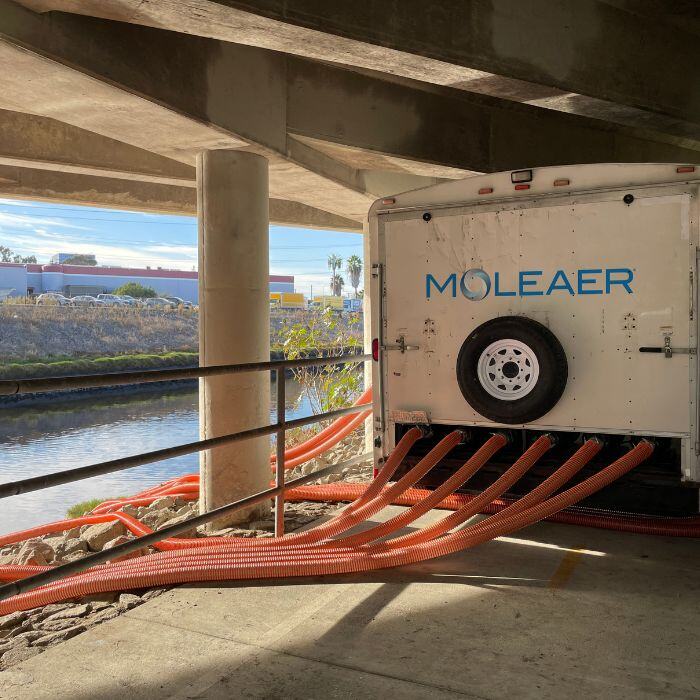
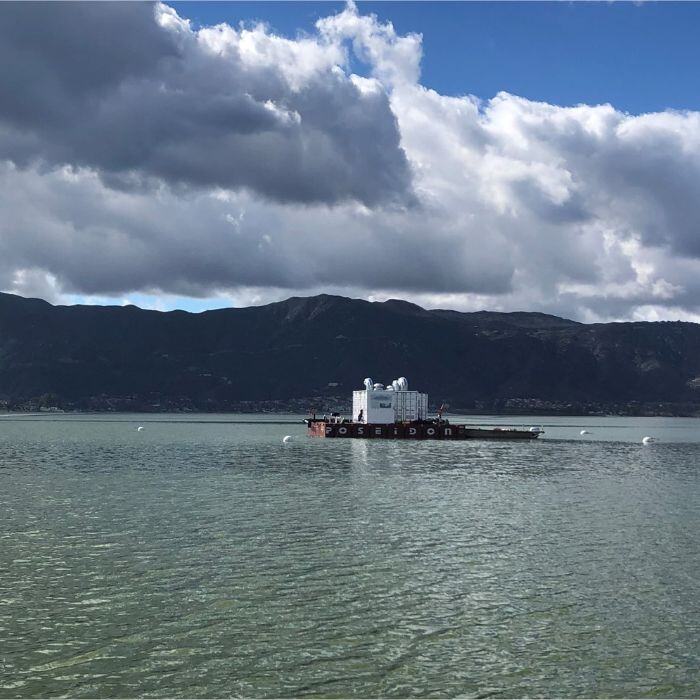
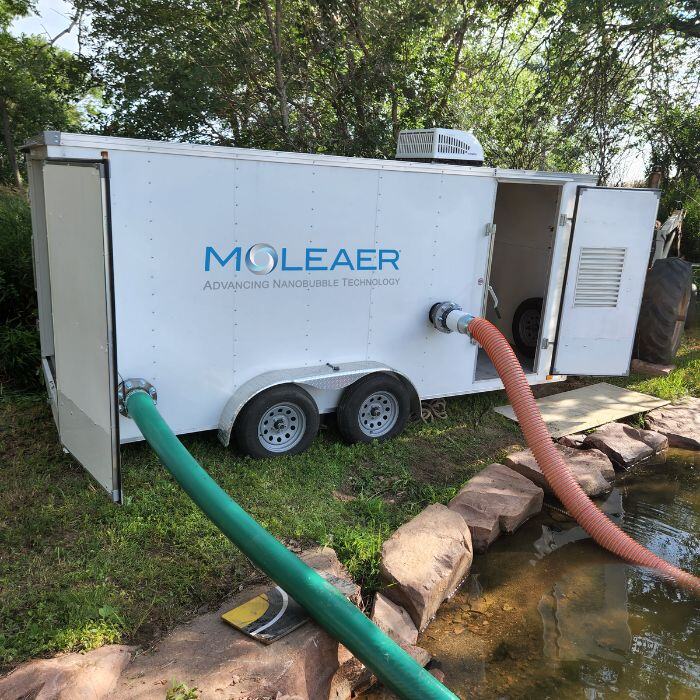
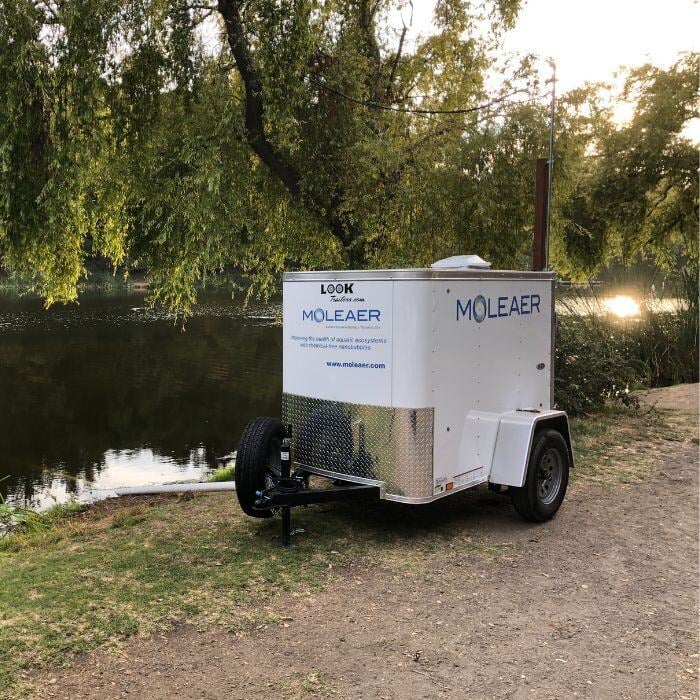
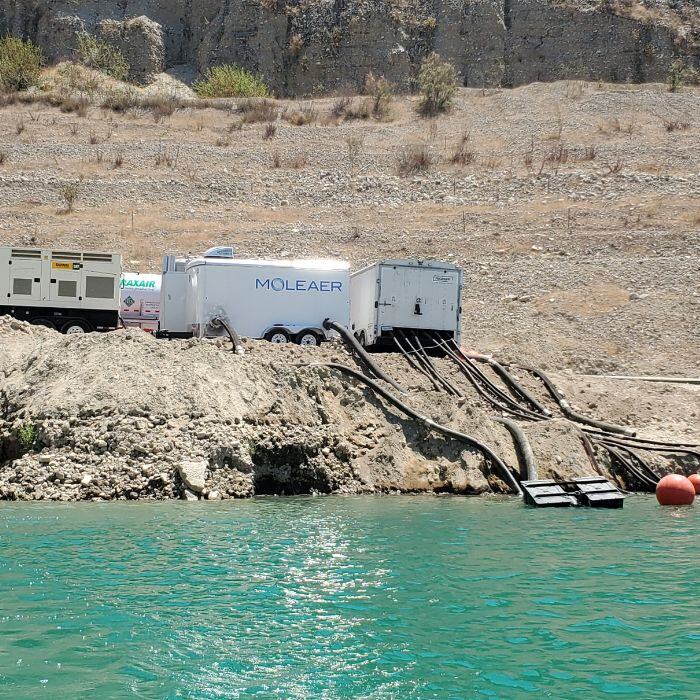
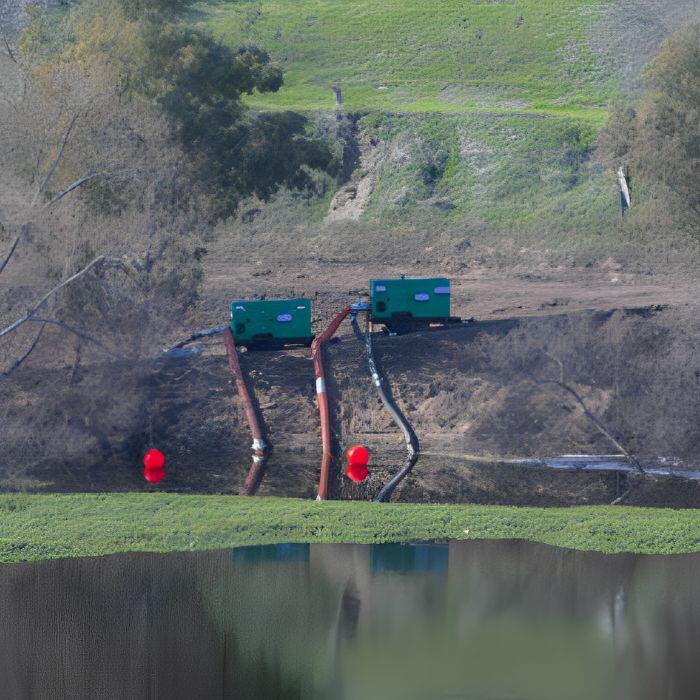
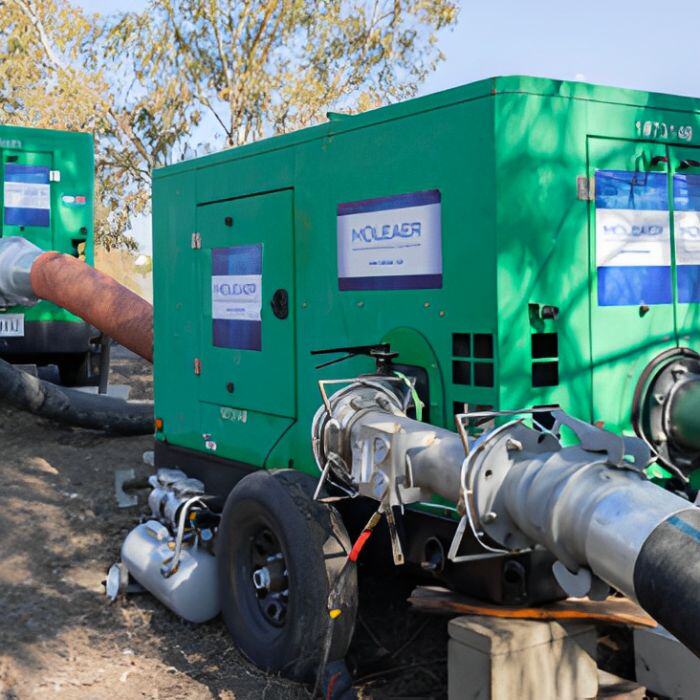
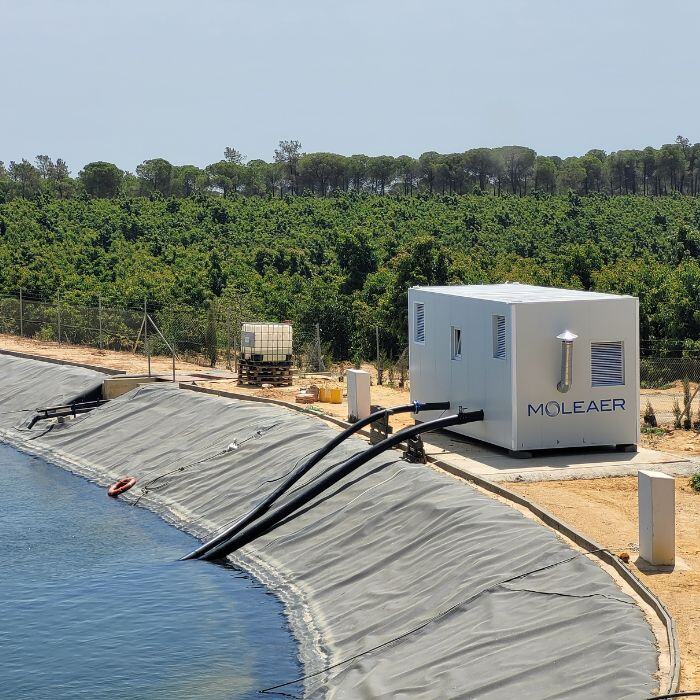
The results from the nanobubbles were much faster than I would have expected. As a chemical engineer who specifies equipment as part of my job, I am also impressed with the quality of the design and build of the generator. I am happy with my local technical representative, with Moleaer as a company and with my results. The trout are healthier and the water quality is fantastic. I’m thrilled with all of it. The investment was worth every penny.
Private trout lake owner in Wisconsin Fresh
This product will revolutionize the way the public sector and homeowner’s associations address water quality in stormwater retention ponds. In less than a month of using the Kingfisher nanobubble equipment, the pond was free of algae and the water was crystal clear. I have managed cities for over 45 years and this product is absolutely amazing.
Former City Manager and pond-front resident
We have been using Moleaer’s nanobubble generator here at the Westin Hapuna Beach Resort since March 2022, and it has been a game changer! We have been absolutely thrilled with the improvements to the health of the plants and fish. After just a short time, the clarity in the pond increased dramatically which has translated into a better experience for our Resort guests, and the fact that it is an all-natural treatment is an added bonus!
Hotel Manager at Westin Hapuna Beach Resort
by Dr. Denise Devotta & Christian Ference, Moleaer
Because it does not involve the use of artificial chemicals, nanobubble technology is increasingly being used as a novel, sustainable tool for algae control and environmental remediation in lakes and ponds. Recently, nanobubble treatment was applied to Lake Elsinore in the City of Lake Elsinore, CA, representing the largest demonstration to date of the technology in the U.S. Historically, the lake has been plagued by moderate to severe harmful cyanobacterial blooms that have resulted in repeated lake closures and unpleasant odors impacting nearby communities. In response, the City of Lake Elsinore implemented a multi-faceted approach to remediate water quality in the lake, including treatment of the Elm Grove Beach Lake area with nanobubble technology. This treatment, installed and commissioned on February 8th, 2024, consists of a barge-mounted, containerized oxygen and ozone nanobubble injection system. The equipment recirculates water at 2,400 GPM. To determine treatment effectiveness, multi-parameter sondes were deployed in seven locations in the treatment area to continuously monitor water quality. Periodic sediment hardness mapping was also conducted. As of this abstract submission, only the first month of operational data has been analyzed. Lake clarity (i.e. Secchi depth) increased by over 200%, from a historical average of 0.2m-0.3m to 0.8m. Oxidation-reduction potential (ORP) also more than doubled, while relative Chl a fluorescence was approximately eight times lower than at the start of treatment (ORP: 263 vs. 119 mV; Chl a: 0.38 vs. 3.20 RFU). This presentation will cover deployment of the nanobubble treatment, the contribution of this treatment to the City’s overall lake management plan, and water quality results from the first six months of operation.
by Dr. Denise Devotta & Christian Ference, Moleaer
Because it does not involve the use of artificial chemicals, nanobubble technology is increasingly being used as a novel, sustainable tool for algae control and environmental remediation in lakes and ponds. Recently, nanobubble treatment was applied to Lake Elsinore in the City of Lake Elsinore, CA, representing the largest demonstration to date of the technology in the U.S. Historically, the lake has been plagued by moderate to severe harmful cyanobacterial blooms that have resulted in repeated lake closures and unpleasant odors impacting nearby communities. In response, the City of Lake Elsinore implemented a multi-faceted approach to remediate water quality in the lake, including treatment of the Elm Grove Beach Lake area with nanobubble technology. This treatment, installed and commissioned on February 8th, 2024, consists of a barge-mounted, containerized oxygen and ozone nanobubble injection system. The equipment recirculates water at 2,400 GPM. To determine treatment effectiveness, multi-parameter sondes were deployed in seven locations in the treatment area to continuously monitor water quality. Periodic sediment hardness mapping was also conducted. As of this abstract submission, only the first month of operational data has been analyzed. Lake clarity (i.e. Secchi depth) increased by over 200%, from a historical average of 0.2m-0.3m to 0.8m. Oxidation-reduction potential (ORP) also more than doubled, while relative Chl a fluorescence was approximately eight times lower than at the start of treatment (ORP: 263 vs. 119 mV; Chl a: 0.38 vs. 3.20 RFU). This presentation will cover deployment of the nanobubble treatment, the contribution of this treatment to the City’s overall lake management plan, and water quality results from the first six months of operation.
By Dr. Denise Devotta, Moleaer & Jon Morales, Middle Fork Crow River Watershed District
Being a terminal lake, Tadd Lake had been plagued with high nutrient levels, organic matter (or “muck”) accumulation, low water clarity, foul odor, and excessive algae growth for years. Because it does not involve the use of artificial chemicals, nanobubble (NB) technology is increasingly being used as a novel, sustainable tool for water quality restoration in lakes. In July 2024, the Middle Fork Crow River Watershed District (MCFRWD) implemented a multi-faceted restoration program in Tadd Lake, with nanobubble treatment as the foundational component of this program. Monitoring data from the first month of NB treatment indicate reduced dissolved nutrient load, and significant improvements in water clarity, muck, dissolved oxygen, and oxidation-reduction potential levels in the lake. Our presentation will highlight these results, and results from monitoring after July, to showcase longer-term impacts of NB treatment on the lake.
by Dr. Denise Devotta & Christian Ference, Moleaer
Because it does not involve the use of artificial chemicals, nanobubble technology is increasingly being used as a novel, sustainable tool for algae control and environmental remediation in lakes and ponds. Recently, nanobubble treatment was applied to Lake Elsinore in the City of Lake Elsinore, CA, representing the largest demonstration to date of the technology in the U.S. Historically, the lake has been plagued by moderate to severe harmful cyanobacterial blooms that have resulted in repeated lake closures and unpleasant odors impacting nearby communities. In response, the City of Lake Elsinore implemented a multi-faceted approach to remediate water quality in the lake, including treatment of the Elm Grove Beach Lake area with nanobubble technology. This treatment, installed and commissioned on February 8th, 2024, consists of a barge-mounted, containerized oxygen and ozone nanobubble injection system. The equipment recirculates water at 2,400 GPM. To determine treatment effectiveness, multi-parameter sondes were deployed in seven locations in the treatment area to continuously monitor water quality. Periodic sediment hardness mapping was also conducted. As of this abstract submission, only the first month of operational data has been analyzed. Lake clarity (i.e. Secchi depth) increased by over 200%, from a historical average of 0.2m-0.3m to 0.8m. Oxidation-reduction potential (ORP) also more than doubled, while relative Chl a fluorescence was approximately eight times lower than at the start of treatment (ORP: 263 vs. 119 mV; Chl a: 0.38 vs. 3.20 RFU). This presentation will cover deployment of the nanobubble treatment, the contribution of this treatment to the City’s overall lake management plan, and water quality results from the first six months of operation.
by Dr. Denise Devotta & Christian Ference, Moleaer
Because it does not involve the use of artificial chemicals, nanobubble technology is increasingly being used as a novel, sustainable tool for algae control and environmental remediation in lakes and ponds. Recently, nanobubble treatment was applied to Lake Elsinore in the City of Lake Elsinore, CA, representing the largest demonstration to date of the technology in the U.S. Historically, the lake has been plagued by moderate to severe harmful cyanobacterial blooms that have resulted in repeated lake closures and unpleasant odors impacting nearby communities. In response, the City of Lake Elsinore implemented a multi-faceted approach to remediate water quality in the lake, including treatment of the Elm Grove Beach Lake area with nanobubble technology. This treatment, installed and commissioned on February 8th, 2024, consists of a barge-mounted, containerized oxygen and ozone nanobubble injection system. The equipment recirculates water at 2,400 GPM. To determine treatment effectiveness, multi-parameter sondes were deployed in seven locations in the treatment area to continuously monitor water quality. Periodic sediment hardness mapping was also conducted. As of this abstract submission, only the first month of operational data has been analyzed. Lake clarity (i.e. Secchi depth) increased by over 200%, from a historical average of 0.2m-0.3m to 0.8m. Oxidation-reduction potential (ORP) also more than doubled, while relative Chl a fluorescence was approximately eight times lower than at the start of treatment (ORP: 263 vs. 119 mV; Chl a: 0.38 vs. 3.20 RFU). This presentation will cover deployment of the nanobubble treatment, the contribution of this treatment to the City’s overall lake management plan, and water quality results from the first six months of operation.
By Dr. Denise Devotta, Moleaer & Jon Morales, Middle Fork Crow River Watershed District
Being a terminal lake, Tadd Lake had been plagued with high nutrient levels, organic matter (or “muck”) accumulation, low water clarity, foul odor, and excessive algae growth for years. Because it does not involve the use of artificial chemicals, nanobubble (NB) technology is increasingly being used as a novel, sustainable tool for water quality restoration in lakes. In July 2024, the Middle Fork Crow River Watershed District (MCFRWD) implemented a multi-faceted restoration program in Tadd Lake, with nanobubble treatment as the foundational component of this program. Monitoring data from the first month of NB treatment indicate reduced dissolved nutrient load, and significant improvements in water clarity, muck, dissolved oxygen, and oxidation-reduction potential levels in the lake. Our presentation will highlight these results, and results from monitoring after July, to showcase longer-term impacts of NB treatment on the lake.
.jpg?width=300&height=225&name=Video%20Cover%20(2).jpg)

.jpg?width=300&height=225&name=Video%20Cover%20(1).jpg)
Nanobubble treatment by Moleaer offers a sustainable solution by oxygenating the entire water column, particularly the lake bottom where sediments, a major source of internal nutrient loading, are found. By reversing oxygen-depleted conditions, nanobubbles help immobilize phosphorus and curtail nitrogen release, reducing algae growth and preventing future blooms. This increases the lake’s oxidation-reduction potential (ORP), enhancing its resilience to algae toxin loading and reducing muck accumulation, making the lake safer for human recreation and aquatic life.
Moleaer's nanobubble technology supports pond and lake algae control by creating a mild oxidative environment and increasing dissolved oxygen throughout the water column that allows these water bodies' ecosystems to break down unwanted organic matter, reducing the negative impacts of nutrients that can encourage algae blooms.
Our nanobubble technology efficiently oxygenates the entire water column, even in the sediment layer, to promote beneficial bacteria and reduce algae and muck accumulation for healthier and more resilient water bodies.
Nanobubbles also help improve water's clarity and quality, reduce excess nutrients going into the water column, prevent scum and odors, improve organic compounds decomposition, and increase dissolved oxygen (DO) in the sediment to digest muck.
Moleaer's nanobubbles can be used for large pond and lake algae control and deliver visible and quality results. Therefore, both large-scale lake or pond managers and those who have these water bodies in their backyards can leverage our technology to improve water clarity and quality and reduce algae bloom occurrence.
Prevention is crucial to avoid algae growth. Since nanobubbles help restore aquatic ecosystems and natural lake recovery processes, this technology can play a key role in proactive pond or lake management plans.
Nanobubbles improve overall water quality, making lakes and ponds more resilient to algal blooms and keeping water healthier for longer. Used in complement with your existing integrated pest management plan, nanobubbles are a chemical-free tool to reduce algae and odor compounds, while simultaneously oxygenating the sediment layer to digest muck and sequester nutrients that feed algae.
Moleaer's nanobubble pond water treatment systems are easy to install because they are shore mounted with only a suction and discharge pipe needed in addition to power.
Our Kingfisher nanobubble generator is smaller, with simple controls, only 3 moving parts, 120V household power required, and quiet operation (57 dB at 3 feet away). It's also lightweight and robust to withstand the elements.
If you need a larger size, our Clear and Titan nanobubble system can treat larger-sized water bodies and offer easy installation and maintenance.
Moleaer's nanobubble technology helps naturally restore water bodies without the use of chemicals. By delivering oxygen to the bottom of the lake, nanobubbles kick start natural lake recovery processes and boost resilience to common problems like algae, foul odors and nutrients.
Nanobubbles provide oxygen and an optimal habitat with better-quality water for aquatic life, creating a healthy aquatic environment where these ecosystems can develop.
In fact, Moleaer uses nanobubbles for greenhouse growers to improve crop quality and lower disease.